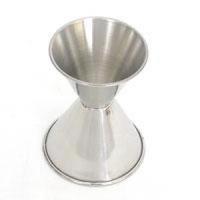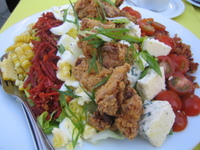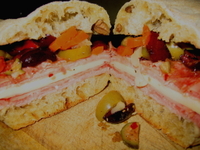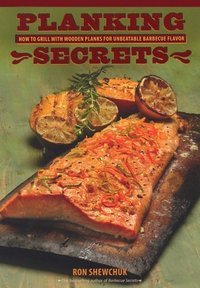 This week So Much On My Plate returned to New Orleans…kind of. I made a Voodoo shrimp recipe with BC side-stripe prawns and uses my barbecue for a cedar plank variation on the classic Bananas Foster!
This week So Much On My Plate returned to New Orleans…kind of. I made a Voodoo shrimp recipe with BC side-stripe prawns and uses my barbecue for a cedar plank variation on the classic Bananas Foster!
Voodoo Shrimp
I picked up this recipe in New Orleans from chef Duke LoCicero at Café Giovanni. He and his family are real troopers, recovering from the devastation of Hurricane Katrina in record time. The restaurant was looted, and they had to clean up $30,000 worth of food that had spoiled in the fridge and freezer due to the power outage.
Anyway, this recipe is great as an appetizer for four people, or serves two as a main course entrée, either on pasta, or with lots of crusty bread to mop up the juices. I’ve given it a BC twist by using BC side-stripe shrimp, which are in season for most of the summer. You could use any other large shrimp as a substitute. Don’t overcook them!
Ingredients:
1 pound side-stripe shrimp, shelled and de-veined if necessary
1/4 cup olive oil
1 tbsp. Cajun spice rub, or other hot spice mixture
1/4 cup butter
2 cloves garlic, chopped
2 medium tomatoes, seeded and diced
1/2 cup Southern Comfort liqueur, in a small heatproof ramekin
1/2 cup sweet Thai chili sauce (available at most Asian markets)
1/4 cup fresh basil leaves, chopped
Pour the olive oil and the Cajun spice over the shrimp and toss to blend well. Set aside for up to half an hour.
In a heavy skillet on medium-high heat, melt the butter, then add the garlic. Saute until translucent, then add in the tomatoes and stir. When the tomatoes soften, add the shrimp mixture and cook the shrimp, stirring, until they just turn opaque. Pour in the Southern Comfort and, if cooking on a gas stove, tilt the pan slightly into the flame to ignite it and flambé the shrimp. On an electric stove you can carefully ignite the liqueur with a match. When the flames burn out, add the Thai chili sauce and the basil leaves. Stir again to mix well and serve immediately.
Planked Bananas Foster
This recipe is from Ron Shewchuk’s Planking Secrets. It’s a variation on the classic Bananas Foster recipe invented in New Orleans in the 1950’s.
Ingredients
1 cedar plank, soaked overnight or at least 1 hour
4 ripe but not overripe bananas, peeled, then cut in length halfwise, then cut in half
1/4 cup butter
1 cup brown sugar
1/2 tsp. cinnamon
1/4 cup banana liqueur
1/4 cup dark rum in a small bowl or ramekin
4 scoops vanilla ice cream
Preheat your grill on medium-high for 5 or 10 minutes. Rinse the plank and put it on the cooking grate. Cover the grill and heat the plank for 4-5 minutes, or until it starts to throw off a bit of smoke and crackles lightly. Reduce heat to medium.
Put the bananas on the plank, cut side up, and cover the grill. Cook for 8 to 10 minutes until they are light golden and soft but not mushy. Remove from plank and set aside.
Combine the butter, sugar and cinnamon in a heavy skillet and heat, stirring, until the sugar dissolves. Stir in the banana liqueur and transfer the bananas to the skillet. When the mixture is warm, carefully add the rum. If you’re cooking on a gas stove, tip the pan slightly to ignite the rum. On electric, use a barbecue lighter or match to do the same. Serve hot, placing the bananas on a scoop of ice cream and spooning the sauce over the top.


















